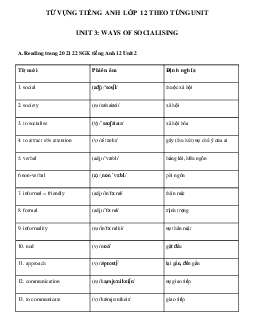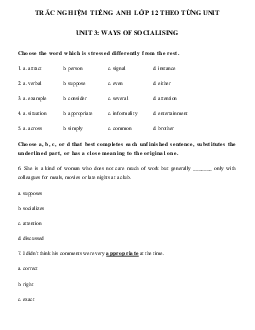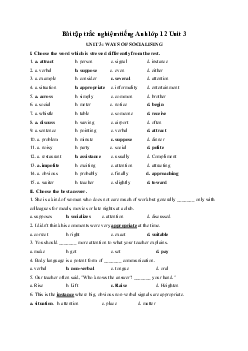



Preview text:
SOẠN TIẾNG ANH LỚP 12 MỚI THEO UNIT
UNIT 3 THE GREEN MOVEMENT LOOKING BACK
Pronunciation - Phát âm
1. Listen and underline the sounds that are assimilated. Lắng nghe và gạch dưới các phát âm được đồng hóa. Click để nghe Đáp án
1. This is the best book on environmental issues.
2 . We believe that both sides should focus more on energy-saving projects.
3. We'll make the earth a green planet.
4. Wind power produces no greenhouse gas emissions during operation.
5. Bio-fuels are obtained from biodegradable plant material.
2. Listen and complete the sentences. Nghe và hoàn thành câu Click để nghe Đáp án 1 - green beans 2 - town planning 3 - food poisoning 4 - Green Britain 5 - light bulbs
Vocabulary - Từ vựng
Complete the sentences with the correct form of the words/phrases in the box. Hoàn
thành câu với hình thức đúng của các từ / cụm từ trong khung. Đáp án 1 - disposal of 2 - depleted 3 - clutter 4 - Organic 5 - combustion 6 - Soot particles 7 - pathway Hướng dẫn dịch
1 - Trọng tâm của cuộc hội thảo sẽ là xử lý chất thải nguy hại.
2 - Một số người vẫn nghĩ rằng tài nguyên thiên nhiên của chúng ta không bao giờ cạn kiệt.
3 - Cách tốt nhất để dọn dẹp lộn xộn từ ngôi nhà của bạn là xếp nó thành hộp "ném đi", "bỏ đi" và "cho đi".
4 - Nông nghiệp hữu cơ tránh sử dụng phân hóa học và thuốc trừ sâu.
5 - Quá trình đốt cháy không hoàn chỉnh thường gây các sản phẩm phụ độc hại.
6 - Các phân tử bụi than quá nhỏ nên chúng có thể xâm nhập vào dòng máu gây ra các vấn đề về sức khỏe.
7 - Công nghệ xanh đã là một phần của con đường dẫn đến tiến bộ kinh tế. Grammar - Ngữ pháp
1. Combine the simple sentences into compound sentences, using appropriate
conjunctions. Kết hợp câu đơn giản thành câu ghép, sử dụng liên từ thích hợp. Đáp án
1 - We read food labels carefully because we want to buy only organic products.
2 - The burning of fossil fuels is the largest source of greenhouse gas emissions and causes air pollution.
3 - Shall we organise a tree-planting day or launch a recycling campaign at school?
4 - Regular exercise is essential to longevity, but it is not the only factor.
5 - Noise pollution can cause stress and psychological problems, so try to spend some
peaceful, quiet time in nature.
2. Combine the simple sentences into complex sentences, using the word in brackets.
Kết hợp câu đơn giản thành câu ghép, sử dụng liên từ thích hợp. Đáp án
1 - If we change our consumption habits, we can reduce our carbon footprint.
2 - We should use bicycles instead of cars because this will help reduce exhaust fumes and pollution.
3 - When fossil fuels are burned, they emit harmful gas into the environment.
4 - Protect the environment where you live.
5 - We reuse bags, old clothes and scrap paper at home so that we can reduce waste.
3. Match the simple sentences. Then write complex sentences with which. Nối câu đơn.
Sau đó viết những câu ghép với which. Đáp án 1. d 2. a 3. e 4. b 5. c




